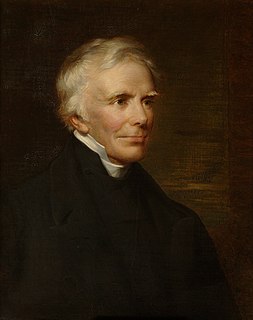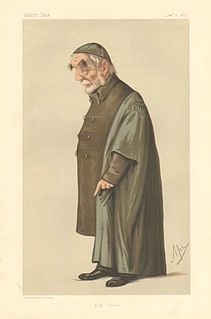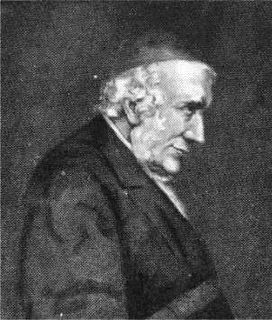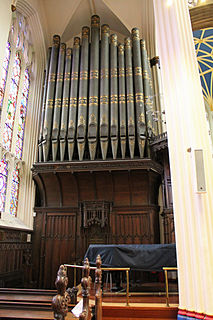
Anglicanism is a Western Christian tradition that has developed from the practices, liturgy, and identity of the Church of England following the English Reformation, in the context of the Protestant Reformation in Europe. It is one of the largest branches of Christianity, with around 110 million adherents worldwide as of 2001.

Anglo-Catholicism, Anglican Catholicism, or Catholic Anglicanism comprises people, beliefs and practices within Anglicanism that emphasise the Catholic heritage and identity of the various Anglican churches.

John Henry Newman, C.O. was an English theologian, scholar and poet, first an Anglican priest and later a Catholic priest and cardinal, who was an important and controversial figure in the religious history of England in the 19th century. He was known nationally by the mid-1830s, and was canonised as a saint in the Catholic Church in 2019.

John Keble was an English churchman and poet, one of the leaders of the Oxford Movement. Keble College, Oxford, was named after him.

Edward Bouverie Pusey was an English Anglican cleric, for more than fifty years Regius Professor of Hebrew at the University of Oxford. He was one of the leading figures in the Oxford Movement.

Hugh James Rose (1795–1838) was an English Anglican priest and theologian who served as the second Principal of King's College, London.

Henry Parry Liddon (1829–1890), also known as H. P. Liddon, was an English theologian. From 1870 to 1882, he was Dean Ireland's Professor of the Exegesis of Holy Scripture at the University of Oxford.

Henry Edward Manning was an English prelate of the Roman Catholic church, and the second Archbishop of Westminster from 1865 until his death in 1892.

The Oxford Movement was a movement of High Church members of the Church of England which eventually developed into Anglo-Catholicism. The movement, whose original devotees were mostly associated with the University of Oxford, argued for the reinstatement of some older Christian traditions of faith and their inclusion into Anglican liturgy and theology. They thought of Anglicanism as one of three branches of the "one, holy, catholic, and apostolic" Christian church. By the 1840s many participants decided that the Anglican Church lacked grace, and converted to Roman Catholicism.

The term high church refers to beliefs and practices of Christian ecclesiology, liturgy, and theology that emphasize formality and resistance to modernisation. Although used in connection with various Christian traditions, the term originated in and has been principally associated with the Anglican tradition, where it describes churches using a number of ritual practices associated in the popular mind with Roman Catholicism and Eastern Orthodoxy. The opposite tradition is low church. Contemporary media discussing Anglican churches erroneously prefer the terms evangelical to low church and Anglo-Catholic to high church, even though their meanings do not exactly correspond. Other contemporary denominations that contain high church wings include some Lutheran, Presbyterian, and Methodist churches.

Ritualism, in the history of Christianity, refers to an emphasis on the rituals and liturgical ceremony of the church, in particular of Holy Communion.
William Henry Sewell, English divine and author, helped to found two public schools along high church Anglican lines. A devout churchman, learned scholar and reforming schoolmaster, he was strongly influenced by the Tractarians.

The Cambridge Camden Society, known from 1845 as the Ecclesiological Society, was a learned architectural society founded in 1839 by undergraduate students at Cambridge University to promote "the study of Gothic Architecture, and of Ecclesiastical Antiques." Its activities would come to include publishing a monthly journal, The Ecclesiologist, advising church builders on their blueprints, and advocating a return to a medieval style of church architecture in England. At its peak influence in the 1840s, the society counted over 700 members in its ranks, including bishops of the Church of England, deans at Cambridge University, and Members of Parliament. The society and its publications enjoyed wide influence over the design of English churches throughout the 19th century, and are often known as the ecclesiological movement.

Anglican doctrine is the body of Christian teachings used to guide the religious and moral practices of Anglicans.

The Caroline Divines were influential theologians and writers in the Anglican Church who lived during the reigns of King Charles I and, after the Restoration, King Charles II. There is no official list of Caroline-era divines; they are defined by the era in which they lived, and Caroline Divines hailed from England, Ireland, Scotland, and Wales. However, of these four nations, it is Caroline England which is most commonly considered to have fostered a golden age of Anglican scholarship and devotional writing, despite the socio-cultural upset of civil war, regicide, and military rule under Oliver Cromwell. Importantly, the term divine is restricted neither to canonised saints nor to Anglican figures, but is used of many writers and thinkers in the wider Christian church.

Loss and Gain is a philosophical novel by John Henry Newman published in 1848. It depicts the culture of Oxford University in the mid-Victorian era and the conversion of a young student to Roman Catholicism. The novel went through nine editions during Newman's lifetime, and thirteen printings. It was the first work Newman published after his conversion to Roman Catholicism in 1845.
The Library of Anglo-Catholic Theology was a series of 19th-century editions of theological works by writers in the Church of England, devoted as the title suggests to significant Anglo-Catholic figures. It brought back into print a number of works from the 17th century, concentrating though not exclusively on the Caroline Divines. The publication of the Library, from 1841, was connected with the Oxford Movement which had begun in 1833; some of the editors, such as William John Copeland and Charles Crawley were clearly identified with the movement. However the interests of the Library diverged early from those of the Tractarians. A total of 95 volumes by 20 writers was published over a dozen years; the plan, originally, had been to include 53 authors. The Library of Anglo-Catholic Theology was founded in response to the Parker Society.
The Tracts for the Times were a series of 90 theological publications, varying in length from a few pages to book-length, produced by members of the English Oxford Movement, an Anglo-Catholic revival group, from 1833 to 1841. There were about a dozen authors, including Oxford Movement leaders John Keble, John Henry Newman and Edward Bouverie Pusey, with Newman taking the initiative in the series, and making the largest contribution. With the wide distribution associated with the tract form, and a price in pennies, the Tracts succeeded in drawing attention to the views of the Oxford Movement on points of doctrine, but also to its overall approach, to the extent that Tractarian became a synonym for supporter of the movement.
Godfrey Faussett (c.1781–1853) was an English clergyman and academic, Lady Margaret Professor of Divinity at Oxford from 1827. He was known as a controversialist. As a churchman he exemplified the high-and-dry tradition.

Church music in Scotland includes all musical composition and performance of music in the context of Christian worship in Scotland, from the beginnings of Christianisation in the fifth century, to the present day. The sources for Scottish Medieval music are extremely limited due to factors including a turbulent political history, the destructive practices of the Scottish Reformation, the climate and the relatively late arrival of music printing. In the early Middle Ages, ecclesiastical music was dominated by monophonic plainchant, which led to the development of a distinct form of liturgical Celtic chant. It was superseded from the eleventh century by more complex Gregorian chant. In the High Middle Ages, the need for large numbers of singing priests to fulfill the obligations of church services led to the foundation of a system of song schools, to train boys as choristers and priests. From the thirteenth century, Scottish church music was increasingly influenced by continental developments. Monophony was replaced from the fourteenth century by the Ars Nova consisting of complex polyphony. Survivals of works from the first half of the sixteenth century indicate the quality and scope of music that was undertaken at the end of the Medieval period. The outstanding Scottish composer of the first half of the sixteenth century was Robert Carver, who produced complex polyphonic music.












